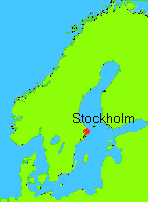Meet the Middle Ages
BackStockholm

Stockholm is presumed to have been founded by Birger Jarl in mid-13th century. At that time, it lay in central Sweden and therefore became important to the trade between east and west.
As ear1y as in 1289, Stockholm is described as the largest town in Sweden. Ten years later, the town was the capital. The town where the King was staying automatically became the capital of the country. In mid-15th century, Stockholm had about 5,000 inhabitants.
Swedes, Germans and Finns lived in Stockholm. Most of the Germans were wealthy merchants, with contacts in the other Hanseatic towns. The Finns, on the contrary, were poor day-workers and labourers. Among the Swedes there were rich merchants as well as poor workers.
Because of its position on Lake Mälaren, Stockholm was like a lock. In the late Middle Ages, it was impossible to pass the town with cargoes from the agricultural area round Lake Mälaren or from the mines of Bergslagen, without paying duties to Stockholm. This made the King and the Hanseatic League more interested in the town. Gradually, it became the leading town of the country.
During the early 17th century, the leaders and rulers of the country lived in Stockholm. From this time on, it is therefore correct to speak of Stockholm as the capital of Sweden.
Medieval Stockholm lay on Stadsholmen (the present-day Old Town), Riddarholmen and Helgeandsholmen, three small islands. The town was fortified and already in the 13th century it had a castle with a tower crowned by three crowns. The castle therefore was called "Three Crowns". It was burnt down in May 1697, and was replaced by the present-day Castle of Stockholm. The Old Town gives a medieval impression because of its old narrow streets and alleys.